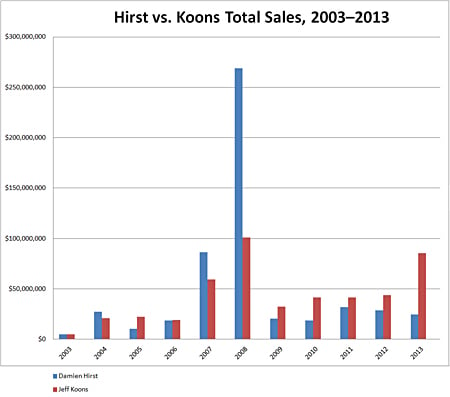
In light of the Post-War consumer boom, Pop Art came to the forefront of the American and British art scenes in the 1950s, introducing aesthetics that were exciting and even shocking to most. It was brash, fun, hostile, and upsetting to the artistic establishment of the time, namely Abstract Expressionism, which virtually obliterated subject. Through a boldness of palette, a hard graphic line, and content derived from popular culture, especially advertising, one of Pop Art’s greatest proponents, Andy Warhol (American, 1928–1987), introduced his iconic subjects: Marilyn Monroe, Elvis, Campbell’s Soup, and Brillo.
Andy Warhol, Coca Cola (3), 1962, casein on cotton, sold at Sotheby’s New York
Now, generations later, works by Warhol and his fellow Pop artists are being acquired at auction and on the private market for astronomical prices. During the most recent Contemporary Art Evening Auction on November 13, 2013 at Sotheby’s New York, Warhol’s Silver Car Crash achieved US$105 million (with Buyer’s Premium). At Christie’s New York the evening before, Warhol’s hand-painted Coca Cola did not fare so poorly either, producing a result just over US$57 million. The work of Roy Lichtenstein (American, 1923–1997), whose output was not nearly as large as Warhol’s, has also produced comparable results, including: Woman with Flowered Hat (US$56 million, Christie’s New York, May 15, 2013) and Sleeping Girl (US$44 million, Sotheby’s New York, May 9, 2012). It should not be overlooked just how important these works are in the oeuvre of the respective artists, confirming their rarity and quality as essential masterpieces, but what should also be pointed out is just how desirable Pop Art’s immediately recognizable qualities have become.
Lichtenstein vs. Warhol Total Sales, 2003–2013
More than 60 years after the genesis of Pop Art, artists have riffed, mocked, and incorporated the physical qualities and sensibilities of Pop, mostly those espoused and depicted by Warhol. One does not have to look far beyond the work of Jeff Koons (American, b.1955) and his playful and banal sculptures, or Damien Hirst’s ironically diamond-studded skulls, to realize that artists of a generation later are looking to Pop, and are taking advantage of the art market trends.
Jeff Koons, Balloon Dog (Orange), 1994–2000, mirror-polished stainless steel with transparent color coating, sold at Christie’s New York
Hirst vs. Koons Total Sales, 2003–2013
Artists more closely associated with work inspired by Warhol and his graphic output include Russell Young (British, b.1959), Mickalene Thomas (American, b.1971), and Deborah Kass (American, b.1952). Their limited palette and penchant for the screenprint medium hark back to Warhol and his Factory. As a former photographer and music video producer Russell Young takes a decidedly nostalgic and obvious approach to his work, incorporating his photographic past of medium and subject in his famous work Marilyn Crying, otherwise known as Suicide. Another artist merging the nostalgic aspect of Pop Art with a decidedly contemporary interpretation is Mickalene Thomas, whose depiction of a recent cultural superstar, Michelle Obama, places her directly in dialogue with Warhol’s portraits of Jacqueline Kennedy Onassis. The artist Deborah Kass has also appropriated the technical and stylistic language of Warhol. Beginning in 1992, Kass created The Warhol Project, which spawned a series of works on subjects that were both personal and political, namely The Jewish Jackie Series.
Russell Young, Jane Fonda, 2004, acrylic and enamel screenprint on canvas
Most recently, artnet specialists Gracie Mansion and Alex Benrimon interviewed Deborah Kass and Mickalene Thomas. Works by these artists, among others whose works harken back to Pop Art, will be offered on artnet Auctions in the inaugural sale Neo Pop!, January 23 through 30.